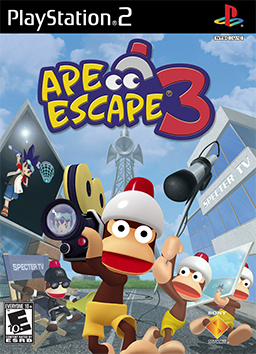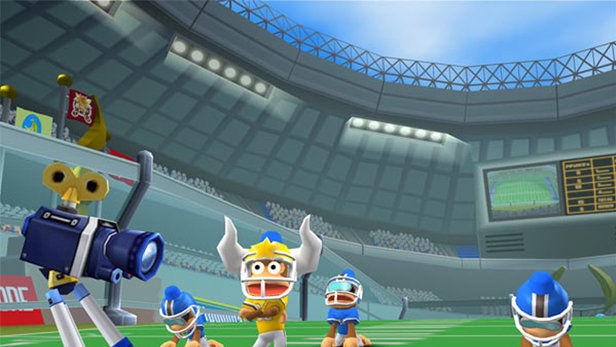12/13/2021
Review of Ape Escape 3
Developed by: Japan Studio
2005, PlayStation 2

Multi-format is a stupid term I made up for a videogame genre that I've been thinking about lately. It refers to a game where you change between different types of gameplay frequently. One of the best examples is Another World (9.5). Every few screens in Another World is a different set-piece, and what you're expected to do in each scene changes equally as often. You go from swinging over a cliff on a vine, to swinging in a cage to break it loose, to rolling through an air duct maze, and eventually to piloting an alien spaceship. None of the new mechanics are explained as they're introduced, and you perform them by using a limited set of controls that change depending on the context. Ape Escape 3 is also a multi-format game, but where a lot of Another World's gameplay consists of environmental puzzles, Ape Escape 3 has fun action.
The levels in Ape Escape 3 take place on movie sets, because the main antagonist's plan is to make such mindless television programs that humanity is lulled into a daze, and the apes can take over the world. Each level takes place in a different film genre setting where the apes mockingly reenact famous cinema, and this setup gives the game a reason to jump between new environments and set-pieces constantly, such as a Hong Kong city street or the Titanic. Every area has a huge amount of detail and variety in its set design, and it's all done with the same, clear art style.
The game's action and mechanics are just as varied. In order to catch the apes scattered throughout a level, you will need to drive a race car (with its own set of controls), drive an RC car around a miniature track, pilot a robot that controls like a Virtual-On (7.5) mech, and play a top-down twin-stick shooter segment. Even in the parts of the game where you're using the standard set of items, which all control a little bit differently, the levels are made up of one-off action set-pieces, so they play as uniquely as they feel aesthetically.
The only thing that feels repetitious is the main goal of the game, which is catching the apes. Each ape is kind of like a moon in Super Mario Odyssey (8), but instead of being hidden behind a little puzzle or requiring you to do a specific challenge, the method for catching an ape mostly ends up feeling the same. But before you catch them, they all have their own characteristics and routines, like one that's exercising on the set of a workout video and another one that's wearing a wig in the bed from The Exorcist with its head spinning around.

The multi-format genre works for me because it has the characteristics of one of the things I like most in art, which is when something feels like it was made out of enjoyment instead of obligation to following a formula. Each segment in Another World was made chronologically after the previous scene had been designed. The person who made it didn't plan out the design of the game as a whole, he made each section based on what he thought would be cool to have happen next. In a similar way, Ape Escape 3 feels surprising because it's willing to go in any direction by changing its gameplay at any time, whereas most games won't change the fundamental actions you can perform.
Playing a multi-format game is about changing mechanics frequently, and it works best if they aren't explained and are treated as cursorily as possible, so that adjusting to the new thing will feel as surprising as possible. To that end, the controls need to be simple so they are easy enough to learn, like how everything in Ape Escape 3 is controlled with the analog sticks, and ideally the controls can be figured out through intuition.
Being able to figure out controls through intuition alone with no previous explanation I think is the highest potential for a multi-format game. The part in Another World mentioned earlier, where your character is trapped in a cage hanging on a chain from the ceiling, is an example of that. The solution is to move the direction buttons back and forth to make the cage swing far enough until the chain breaks. Nothing in the game hints at that, or even demonstrated that you could do something other than run or jump up until that point. You think you want to do something, so you try it and it happens. Most of the time in games you know what your character can fundamentally do, and the game is about working within those boundaries, so when a game is about you breaking out of those boundaries it feels emergent, as in it feels like you're acting in the game.